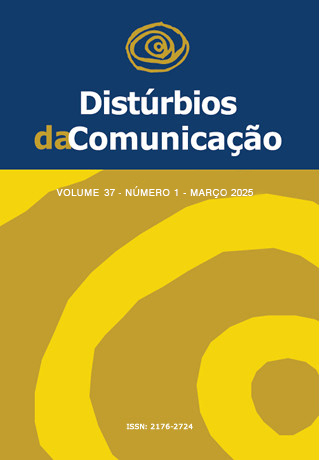Propuesta de formación en vídeo para la auscultación cervical
validación de contenido
DOI:
https://doi.org/10.23925/2176-2724.2025v37i1e68808Palabras clave:
Deglución, Auscultación, Medios Audiovisuales, Trastorno de la Deglución, Terapia de lenguajeResumen
Objetivo: Verificar la concordancia entre evaluadores respecto al contenido de una tutoría como propuesta formativa para la auscultación cervical. Método: se trata de un estudio observacional, conceptual, cuantitativo, que comprende la estructura de validación de un tutorial de salud. El video tutorial se integró en el programa de animación 2D, con la presentación del contenido a través de la interacción con un personaje virtual personalizado. El tutorial consiste en la presentación de conceptos de la evaluación clínica de la deglución y la auscultación cervical, explorando las características acústicas de los sonidos auscultados, la identificación del equipo de amplificación sonora utilizado en su realización, así como el posicionamiento del equipo en la región cervical y la demostración de la aplicación de la técnica, con una duración de ocho minutos. Los datos recolectados fueron analizados a través del índice de validez de contenido, y se verificó la pertinencia de cada ítem, considerando la escala Likert de 5 puntos. La concordancia mínima considerada fue del 78% como criterio para decidir sobre la pertinencia del ítem del instrumento. Resultados: la muestra estuvo constituida por doce especialistas con una edad promedio de 34,4 años, con predominio del sexo femenino, de los cuales el 75% residía en la región sur. El índice de validación de contenido mínimo encontrado fue del 83,3%. Conclusión: el presente estudio validó el contenido del tutorial de auscultación cervical, que incluye la presentación de conceptos y demostración de la aplicación técnica.
Descargas
Citas
Dias V, Bolzan GD. Instruments for acoustic capture and analysis of cervical auscultation signals in speech-language pathology clinic practice: an integrative literature review. Audiol Commun Res. 2021; 26: e2496. Doi: https://doi.org/10.1590/2317-6431-2021-2498
Cardoso MC, Gomes DH. Cervical auscultation in adults without complaint of the deglutition Arq Int Otorrinolaringol. 2010; 14(4): 404-9. Doi: https://doi.org/10.1590/s1809-48722010000400004
Dudik JM, Coyle JL, Sejdic E. Dysphagia Screening: Contributions of Cervical Auscultation Signals and Modern Signal-Processing Techniques. IEEE Trans Hum Mach Syst. 2015; 45(4): 465-77. Doi : https://doi.org/10.1109/thms.2015.2408615
Lagarde ML, Kamalski DM, van den Engel-Hoek L. The reliability and validity of cervical auscultation in the diagnosis of dysphagia: a systematic review. Clin Rehabil. 2015; 30(2):199-207. Doi: https://doi.org/10.1177/0269215515576779
Bergström L, Cichero JA. Dysphagia management: does structured training improve the validity and reliability of cervical auscultation? Int J Speech Lang Pathol .2021;1-11. Doi: https://doi.org/10.1080/17549507.2021.1953592
Jaghbeer, M, Sutt, A. L, & Bergström, L. Dysphagia Management and Cervical Auscultation: Reliability and Validity Against FEES. Dysphagia. 2023; 38(1): 305-314. Doi: https://doi.org/10.1007/s00455-022-10468-8.
Coluci MZ, Alexandre NM, Milani D. Construção de instrumentos de medida na área da saúde. Cienc Amp Saude Coletiva. 2015; 20(3): 925-36. Doi: https://doi.org/10.1590/1413-81232015203.04332013
Cañadas-Osinski, I, Sánchez-Bruno, A. (1998). Categorías de respuesta en escalas tipo Likert. Psicothema, 10(3), 623-66
Canto de Gante, Á. G, Sosa González, W.E., Bautista Ortega, J, Escobar Castillo, J, & Santillán Fernández, A. Escala de Likert: Una alternativa para elaborar e interpretar un instrumento de percepción social. Revista de la alta tecnología y sociedad, (2020). 12(1).
Polit DF, Beck CT. The content validity index: Are you sure you know what’s being reported? critique and recommendations. Res Nurs Amp Health. 2006; 29(5): 489-97. Doi: https://doi.org/10.1002/nur.20147
Nunes ED, Cardoso MC. Validação de conteúdo de um instrumento de triagem em motricidade orofacial. Res Soc Dev. 2023;12(1): e19212139785. Doi: https://doi.org/10.33448/rsd-v12i1.39785
Conselho Federal de Fonoaudiologia 2023 [Internet]: [cited 2023 Jul 01]; Disponível: http// Conselho Federal de Fonoaudiologia – Conselho Federal de Fonoaudiologia – CFFA
Leite SD, Áfio AC, Carvalho LV, Silva JM, Almeida PC, Pagliuca LM. Construction and validation of an Educational Content Validation Instrument in Health. Rev Bras Enferm. 2018 71 (4):1635-41. Doi: https://doi.org/10.1590/0034-7167-2017-0648
Macedo ML, Chaves SP, Amaral AK, Pontes ÉS, Silva DD, Cruz RD, Souza NC. Content and layout development and validation of a vocal health guide for older adults. Rev CEFAC. 2020; 22(1). Doi: https://doi.org/10.1590/1982-0216/20202216619
Arroio LF, Lopes JD, Barros AL, Lima EA, Lopes CT, Santos VB. Development and content validity of a website for patients with coronary artery disease. Rev Bras Enferm . 2023; 76(1). Doi: https://doi.org/10.1590/0034-7167-2022-0302
Hermida PM, Araújo IE. Elaboração e validação do instrumento de entrevista de enfermagem. Rev Bras Enferm. 2006; 59(3): 314-20. Doi: https://doi.org/10.1590/s0034-71672006000300012
Macedo ML, Chaves SP, Amaral AK, Pontes ÉS, Silva DD, Cruz RD, Souza NC. Content and layout development and validation of a vocal health guide for older adults. Rev CEFAC. 2020; 22(1). Doi: https://doi.org/10.1590/1982-0216/20202216619
Alexandre NMC, Coluci MZO. Content validity in the development and adaptation processes of measurement instruments. Ciênc saúde coletiva. 2011;16(7): 3061–8. Doi : https://doi.org/10.1590/S1413-81232011000800006.
Descargas
Publicado
Número
Sección
Licencia
Derechos de autor 2025 LILIANE MENZEN, MARIA CRISTINA DE ALMEIDA FREITAS CARDOSO

Esta obra está bajo una licencia internacional Creative Commons Atribución 4.0.









